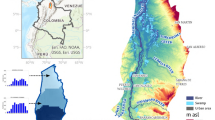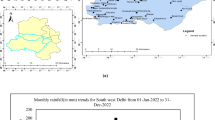Abstract
Uranium ingestion through drinking groundwater is hazardous to human health. The present study aims to find the quality of groundwater and uranium in the Tirunelveli district's groundwater. Two hundred eighty eight samples were collected and analyzed during pre-monsoon (August 2017, 144 samples) and post-monsoon (February 2018, 144 samples). Uranium concentration is in the ranges from 0.5 to 65 ppb (pre-monsoon) and 0.5–52 ppb (post-monsoon). All the samples in both seasons (except one sample during pre-monsoon) have a uranium concentration within the permissible radiological limit of 60 ppb, and 3% of samples in both seasons exceeded the chemical toxicity permissible limit of 30 ppb. The geochemical modelling studies confirm that the lower uranium concentration in groundwater samples may be due to the least dissolution of uranium with the predominantly distributed species of U4O9. Hydrogeochemical investigation shows that the weathering of rocks (sedimentary rocks), and the water is in disequilibrium with reverse ion exchange conditions in the collected samples. The spatial distribution map shows the polluted regions of the uranium and other analyzed water quality parameters (pH, TDS, Cl−, Ca2+, F−, Mg2+, NO3−, SO42−).











Similar content being viewed by others
References
Adithya V S, Chidambaram S, Keesari T, Mohokar H V and Prasanna M V 2019 Occurrence of uranium in groundwater along the lithological contacts in Central Tamilnadu, India: An isotope hydrogeochemical perspective; Expos. Health. 4 277–290.
APHA 1995 Standard methods for the examination of water and wastewater; 19th edn, APHA, Washington DC (USASS).
Brown R M, McClelland N I, Deininger R A and Tozer R G 1970 A water quality index-do we dare; Water Sewage Works 117(10).
CGWB 2009 Central groundwater board. District Groundwater Brochure, Tirunelveli district, Tamil Nadu.
Coyte R M, Jain R C, Srivastava S K, Sharma K C, Khalil A, Ma L and Vengosh A 2018 Large-scale uranium contamination of groundwater resources in India; Environ. Sci. Technol. Lett. 5(6) 341–347.
Devaraj N, Panda B, Chidambaram S, Prasanna M V, Singh D K, Ramanathan A L and Sahoo S K 2021 Spatio-temporal variations of Uranium in groundwater: Implication to the environment and human health; Sci. Total Environ. 775 145787.
Domenico P A and Schwartz F W 1990 Physical and chemical hydrogeology; Wiley, New York, pp. 410–420.
Durov S A 1948 Natural waters and graphic representation of their composition; Dokl. Akad. Nauk. SSSR 59(3) 87–90.
Ganesh D, Senthil Kumar G, Najam L A, Raja V, Neelakantan M A and Ravisankar R 2020 Uranium quantification in groundwater and health risk from its ingestion in and around Tiruvannamalai, Tamil Nadu, India; Radiat. Prot. Dosim. 24 1–12.
Gibbs R J 1970 Mechanism controlling water world chemistry; Science 170 1088–1090.
Giggenbach W F 1988 Geothermal solute equilibria. Derivation of Na–K–Mg–Ca geoindicators; Geochim Cosmochim. Acta 52 2749–2765.
Kouser L, Raghavendra H U and Rao K N 2019 Studies on Uranium hydrogeochemistry in Kamalavathi River Basin, Gulbarga and Yadgir Districts, Karnataka; J. Geol. Soc. India 94(6) 605–610.
Kumar A, Rout S, Narayanan U, Mishra M K, Tripathi R M, Singh J, Kumar S and Kushwaha H S 2011 Geochemical modelling of uranium speciation in the subsurface aquatic environment of Punjab State in India; J. Geol. Mining Res. 3(5) 137–146.
Kumar M, Goswami R, Patel A K, Srivastava M and Das N 2020 Scenario, perspectives and mechanism of arsenic and fluoride co-occurrence in the groundwater: A review; Chemosphere 249 126126.
Lakshmi R V, Raja V, Chidambaram S, Sekar C P and Neelakantan M A 2021a Industrial impact on groundwater quality with special reference to Cr2+ and Pb2+ in coastal aquifers; Environ. Monit. Assess. 193(7) 1–17, https://doi.org/10.1007/s10661-021-09186-9.
Lakshmi R V, Raja V, Sekar C P and Neelakantan M A 2021b Evaluation of groundwater quality in Virudhunagar Taluk, Tamil Nadu, India by using statistical methods and GIS technique; J. Geol. Soc. India 97(5) 527–538, https://doi.org/10.1007/s12594-021-1719-x.
Lapworth D J, Brauns B, Chattopadhyay S, Gooddy D C, Loveless S E, MacDonald A M, McKenzie A A, Muddu S and Nara S N 2021 Elevated uranium in drinking water sources in basement aquifers of southern India; Appl. Geochem. 133 105092.
Marghade D, Malpe D, Duraisamy K, Patil P D and Li P 2021 Hydrogeochemical evaluation, suitability, and health risk assessment of groundwater in the watershed of Godavari basin, Maharashtra, Central India; Environ. Sci. Pollut. Res. 28(15) 18,471–18,494.
Matthess G 1982 The properties of ground water; Wiley, New York, 397p.
Ouyang Y 2005 Evaluation of river water quality monitoring stations by principal component analysis; Water Res. 39(12) 2621–2635.
Panda B, Chidambaram S, Thilagavathi R, Ganesh N, Prasanna M V and Vasudevan U 2020 Source governed trace metal anomalies in groundwater of foothill aquifer and its health effect; Appl. Water Sci. 10(7) 1–10.
Parkhust D L and Appelo C A J 1999 User Guide to PHREEQC (Version 2) – a computer programme for speciation. Batch reaction on dimensional transfer and inverse geochemical calculations; US Department of the Interior, US Geological Survey and Water Resources Investigation Report, pp. 99–4259.
Piper A M 1944 A graphic procedure in the geochemical interpretation of water analysis; J. Trans. Am. Geophys. Union 25(914–923) 491–494.
Puigdomenech I 1999 MEDUSA: Make equilibrium diagrams using sophisticated algorithms, version 2. Inorganic Chemistry. Stockholm Royal Institute of Technology (KTH); http://www.inorg.kth.se.
Punia A, Bharti R and Kumar P 2021 Hydrogeochemical processes governing uranium mobility: Inferences from the anthropogenically disturbed, semi-arid region of India; Arch. Environ. Contam. Toxicol. 81(3) 386–396.
Raja V and Neelakantan M A 2021a Evaluation of groundwater quality with health risk assessment of fluoride and nitrate in Virudhunagar district, Tamil Nadu, India; Arab. J. Geosci. 14(1) 1–18, https://doi.org/10.1007/s12517-020-06385-5.
Raja V and Neelakantan M A 2021b Pollution and noncarcinogenic health risk levels of nitrate and fluoride in groundwater of Ramanathapuram district, Tamil Nadu, India; Int. J. Environ. Anal. Chem., 1–16, https://doi.org/10.1080/03067319.2021.1890063.
Raja V, Lakshmi R V, Sekar C P, Chidambaram S and Neelakantan M A 2021a Health risk assessment of heavy metals in groundwater of industrial township Virudhunagar, Tamil Nadu, India; Arch. Environ. Contam. Toxicol. 80(1) 144–163, https://doi.org/10.1007/s00244-020-00795-y.
Raja V, Sahoo S K, Sreekumar K and Neelakantan M A 2021b High background radiation places and spatial distribution of uranium in groundwater of monazite placer deposit in Kanniyakumari district, Tamil Nadu, India; J. Radioanal. Nucl. Chem., 1–15, https://doi.org/10.1007/s10967-021-07727-7.
Rathore D P, Tarafder P K, Kayal M and Kumar M 2001 Application of a differential technique in laser-induced fluorimetry: Simple and a precise method for the direct determination of uranium in mineralised rocks at the percentage level; Anal. Chim. Acta. 434(2) 201–208.
Richards L A, Kumar A, Shankar P, Gaurav A, Ghosh A and Polya D A 2020 Distribution and geochemical controls of arsenic and uranium in groundwater-derived drinking water in Bihar, India; Int. J. Environ. Res. Public Health 17(7) 2500.
Sahoo P K, Virk H S, Powell M A, Kumar R, Pattanaik J K, Salomão G N, Mittal S, Chouhan L, Nandabalan Y K and Tiwari R P 2022 Meta-analysis of uranium contamination in groundwater of the alluvial plains of Punjab, northwest India: Status, health risk, and hydrogeochemical processes; Sci. Total Environ. 807 151753.
Sidhardhan S, Kumar S A and Thamizharasan A 2018 Study of current quality status of groundwater around Tirunelveli Corporate Dumpsite in Ramayanpatti; Int. J. Res. Appl. Sci. Eng. Technol. 6(I) 1850–1855.
Singh K P, Kishore N, Tuli N, Loyal R S, Kaur M and Taak J K 2018 Uranium contamination of groundwater in southwest parts of Punjab State, India, with special reference to role of basement granite; In: Clean and sustainable groundwater in India, pp. 95–106.
SPSS 2001 SPSS for Windows, Rel. 11.0.1. 2001. Chicago: SPSS Inc.
Thivya C, Chidambaram S, Keesari T, Prasanna M V, Thilagavathi R, Adithya V S and Singaraja C 2016 Lithological and hydrochemical controls on distribution and speciation of uranium in groundwaters of hard-rock granitic aquifers of Madurai District, Tamil Nadu (India); Environ. Geochem. Health. 38(2) 497–509.
Venkatasalam K, Balasubramaniam P and Ramesh G G 2020 Assessment of groundwater quality in inland blocks of Tirunelveli District of Tamil Nadu; IJCS 8(3) 2350–2356, https://doi.org/10.22271/chemi.2020.v8.i3ah.9563.
Vignesh K M and Kiran Y 2020 Comparative analysis of mineral mapping for hyperspectral and multispectral imagery; Arab. J. Geosci. 13(4) 1–12.
Yadav S K, Ramanathan A L, Kumar M, Chidambaram S, Gautam Y P and Tiwari C 2020 Assessment of arsenic and uranium co-occurrences in groundwater of central Gangetic Plain, Uttar Pradesh, India; Environ. Earth Sci. 79(6) 1–4.
Acknowledgement
This work is financially supported by the Board of Research in Nuclear Sciences, BARC, Mumbai, India, Grant no. 36(4)/14/72/2014-BRNS.
Author information
Authors and Affiliations
Contributions
V Raja: Sample collection, analysis and writing original draft; M A Neelakantan: Methodology, project administration and supervision.
Corresponding author
Additional information
Communicated by Abhijit Mukherjee
Supplementary material pertaining to this article is available on the Journal of Earth System Science website (http://www.ias.ac.in/Journals/Journal_of_Earth_System_Science).
Supplementary Information
Below is the link to the electronic supplementary material.
Rights and permissions
About this article
Cite this article
Raja, V., Neelakantan, M.A. Studies on hydrogeochemistry of uranium in groundwater of Tirunelveli district, Tamil Nadu, India. J Earth Syst Sci 132, 146 (2023). https://doi.org/10.1007/s12040-023-02147-5
Received:
Revised:
Accepted:
Published:
DOI: https://doi.org/10.1007/s12040-023-02147-5




